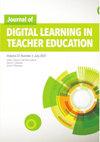翻转模块对职前教师计算思维教学兴趣的跨机构调查
Q1 Social Sciences
Journal of Digital Learning in Teacher Education
Pub Date : 2020-01-02
DOI:10.1080/21532974.2019.1693941
引用次数: 6
摘要
摘要在兴趣的人-物理论的指导下,本研究采用混合方法进行并行三角测量设计,并调查了专业/专业、性别和模块设计对职前教师计算思维教学兴趣的影响。这项研究是在两所美国机构的教育技术课程的三个部分中开设的翻转计算思维模块中进行的。定量分析的结果表明,同时进行Scratch编码和物理计算实践的职前教师比只进行Scratchs编码的同龄人有更高的兴趣水平。我们的定性分析发现,有证据表明,职前教师的兴趣因性别和专业/专业地位而异。最后,我们对未来教师教育中计算思维教学的研究和实践提出了建议。本文章由计算机程序翻译,如有差异,请以英文原文为准。
A cross-institutional investigation of a flipped module on preservice teachers’ interest in teaching computational thinking
Abstract Informed by the person–object theory of interest, this study deployed a mixed-method concurrent triangulation design and investigated the impact of major/specialization, gender, and module design on preservice teachers' interest in teaching computational thinking. The study was conducted in a flipped computational thinking module hosted in three sections of educational technology courses at two U.S. institutions. Results from the quantitative analysis showed that preservice teachers who did both Scratch coding and physical computing practices had a higher level of interest than their peers who only did the Scratch coding only. Our qualitative analysis found evidence that preservice teachers' interest differed by their gender and major/specialization statuses. At the end, we provided suggestions for future research and practice for teaching computational thinking in teacher education.
求助全文
通过发布文献求助,成功后即可免费获取论文全文。
去求助
来源期刊

Journal of Digital Learning in Teacher Education
Social Sciences-Education
CiteScore
4.90
自引率
0.00%
发文量
15
 求助内容:
求助内容: 应助结果提醒方式:
应助结果提醒方式:


